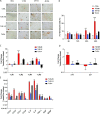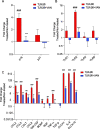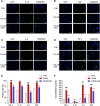Toll-like receptor 2 induced senescence in intervertebral disc cells of patients with back pain can be attenuated by o-vanillin
- PMID: 33863359
- PMCID: PMC8051055
- DOI: 10.1186/s13075-021-02504-z
Toll-like receptor 2 induced senescence in intervertebral disc cells of patients with back pain can be attenuated by o-vanillin
Abstract
Background: There is an increased level of senescent cells and toll-like teceptor-1, -2, -4, and -6 (TLR) expression in degenerating intervertebral discs (IVDs) from back pain patients. However, it is currently not known if the increase in expression of TLRs is related to the senescent cells or if it is a more general increase on all cells. It is also not known if TLR activation in IVD cells will induce cell senescence.
Methods: Cells from non-degenerate human IVD were obtained from spine donors and cells from degenerate IVDs came from patients undergoing surgery for low back pain. Gene expression of TLR-1,2,4,6, senescence and senescence-associated secretory phenotype (SASP) markers was evaluated by RT-qPCR in isolated cells. Matrix synthesis was verified with safranin-O staining and Dimethyl-Methylene Blue Assay (DMMB) confirmed proteoglycan content. Protein expression of p16INK4a, SASP factors, and TLR-2 was evaluated by immunocytochemistry (ICC) and/or by enzyme-linked immunosorbent assay (ELISA).
Results: An increase in senescent cells was found following 48-h induction with a TLR-2/6 agonist in cells from both non-degenerate and degenerating human IVDs. Higher levels of SASP factors, TLR-2 gene expression, and protein expression were found following 48-h induction with TLR-2/6 agonist. Treatment with o-vanillin reduced the number of senescent cells, and increased matrix synthesis in IVD cells from back pain patients. Treatment with o-vanillin after induction with TLR-2/6 agonist reduced gene and protein expression of SASP factors and TLR-2. Co-localized staining of p16INK4a and TLR-2 demonstrated that senescent cells have a high TLR-2 expression.
Conclusions: Taken together our data demonstrate that activation of TLR-2/6 induce senescence and increase TLR-2 and SASP expression in cells from non-degenerate IVDs of organ donors without degeneration and back pain and in cells from degenerating human IVD of patients with disc degeneration and back pain. The senescent cells showed high TLR-2 expression suggesting a link between TLR activation and cell senescence in human IVD cells. The reduction in senescence, SASP, and TLR-2 expression suggest o-vanillin as a potential disease-modifying drug for patients with disc degeneration and back pain.
Keywords: Back pain; Degeneration; Inflammation; Intervertebral disc; Senescence; Senolytics; Toll-like receptor 2; o-Vanillin.
Conflict of interest statement
The authors declare that they have no competing interests.
Figures





Similar articles
-
Senotherapeutic drugs for human intervertebral disc degeneration and low back pain.Elife. 2020 Aug 21;9:e54693. doi: 10.7554/eLife.54693. Elife. 2020. PMID: 32821059 Free PMC article.
-
Curcumin and o-Vanillin Exhibit Evidence of Senolytic Activity in Human IVD Cells In Vitro.J Clin Med. 2019 Mar 29;8(4):433. doi: 10.3390/jcm8040433. J Clin Med. 2019. PMID: 30934902 Free PMC article.
-
Senolytic Combination Treatment Is More Potent Than Single Drugs in Reducing Inflammatory and Senescence Burden in Cells from Painful Degenerating IVDs.Biomolecules. 2023 Aug 16;13(8):1257. doi: 10.3390/biom13081257. Biomolecules. 2023. PMID: 37627322 Free PMC article.
-
For whom the disc tolls: intervertebral disc degeneration, back pain and toll-like receptors.Eur Cell Mater. 2021 Mar 19;41:355-369. doi: 10.22203/eCM.v041a23. Eur Cell Mater. 2021. PMID: 33738788 Review.
-
[Research progress of cellular senescence and senescent secretary phenotype in intervertebral disc degeneration].Zhongguo Xiu Fu Chong Jian Wai Ke Za Zhi. 2012 Dec;26(12):1448-52. Zhongguo Xiu Fu Chong Jian Wai Ke Za Zhi. 2012. PMID: 23316633 Review. Chinese.
Cited by
-
Senolytic and senomorphic secondary metabolites as therapeutic agents in Drosophila melanogaster models of Parkinson's disease.Front Neurol. 2023 Sep 28;14:1271941. doi: 10.3389/fneur.2023.1271941. eCollection 2023. Front Neurol. 2023. PMID: 37840914 Free PMC article. Review.
-
Intervertebral disc degeneration-Current therapeutic options and challenges.Front Public Health. 2023 Jul 6;11:1156749. doi: 10.3389/fpubh.2023.1156749. eCollection 2023. Front Public Health. 2023. PMID: 37483952 Free PMC article. Review.
-
The role of the complement system in disc degeneration and Modic changes.JOR Spine. 2024 Feb 2;7(1):e1312. doi: 10.1002/jsp2.1312. eCollection 2024 Mar. JOR Spine. 2024. PMID: 38312949 Free PMC article. Review.
-
Senescence: A DNA damage response and its role in aging and Neurodegenerative Diseases.Front Aging. 2024 Mar 21;4:1292053. doi: 10.3389/fragi.2023.1292053. eCollection 2023. Front Aging. 2024. PMID: 38596783 Free PMC article. Review.
-
Mechanisms and therapeutic strategies for senescence-associated secretory phenotype in the intervertebral disc degeneration microenvironment.J Orthop Translat. 2024 Mar 12;45:56-65. doi: 10.1016/j.jot.2024.02.003. eCollection 2024 Mar. J Orthop Translat. 2024. PMID: 38495743 Free PMC article. Review.
References
-
- Feng H, Danfelter M, Strömqvist B, Heinegård D. Extracellular matrix in disc degeneration. J Bone Joint Surg Am. 2006;88(Suppl 2):25–29. - PubMed
Publication types
MeSH terms
Substances
Grants and funding
LinkOut - more resources
Full Text Sources
Other Literature Sources

